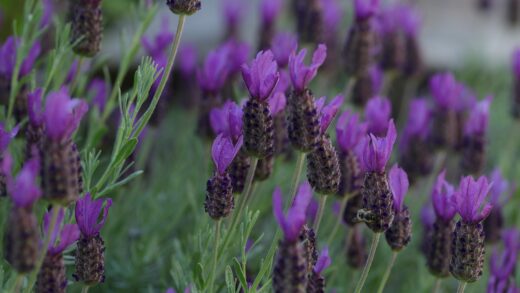Successfully overwintering rosemary is a critical task for gardeners in climates where winter temperatures regularly drop below freezing. As a plant of Mediterranean origin, rosemary is not adapted to withstand harsh, prolonged cold, and its survival depends on receiving adequate protection. The specific strategy for overwintering will vary depending on the local climate and whether the plant is grown in the ground or in a container. For many, this means bringing the plant indoors to a bright, cool location where it can safely ride out the winter months in a state of semi-dormancy. Proper preparation and care during this period are essential for ensuring the plant emerges healthy and ready for new growth in the spring.
Assessing climate and hardiness
The first step in developing an overwintering strategy for rosemary is to understand the specific climate of the growing region and the hardiness of the particular rosemary cultivar. Rosemary’s cold tolerance can vary, with some varieties being more resilient than others. Generally, most common rosemary varieties are considered hardy to about -6 to -9 degrees Celsius (15 to 20 degrees Fahrenheit), placing them in USDA hardiness zones 8-10. Some specific cultivars, like ‘Arp’ or ‘Hill Hardy’, have been bred for improved cold tolerance and may survive in zone 7, or even zone 6 with significant protection.
It is crucial for gardeners to know their specific hardiness zone. This information dictates whether it is feasible to even attempt leaving a rosemary plant outdoors for the winter. In zones 8 and warmer, an established in-ground rosemary will typically survive the winter with minimal protection. In zone 7, survival outdoors is possible but not guaranteed and will require careful site selection and protective measures. In zones 6 and colder, rosemary will not survive the winter in the ground and must be grown in a container that can be moved to a protected location.
Beyond the hardiness zone, the microclimate of the garden also plays a significant role. A plant situated in a location that is sheltered from harsh winter winds, such as against a south-facing stone or brick wall, will be in a much better position to survive the cold than one in an open, exposed site. The radiant heat absorbed and released by the wall can create a microclimate that is several degrees warmer than the surrounding garden, which can make the difference between survival and death for a borderline-hardy plant.
Therefore, a thorough assessment of the local climate is non-negotiable. One must consider not just the average minimum winter temperature, but also the potential for sudden cold snaps, the duration of freezing temperatures, and the presence of protective snow cover, which can act as a natural insulator. This knowledge allows a gardener to make an informed decision about whether to provide winter protection for an in-ground plant or to opt for the safer strategy of container growing and indoor overwintering.
Preparing in-ground plants for winter
In climates where rosemary is borderline hardy (typically zone 7), several steps can be taken in the autumn to increase the chances of an in-ground plant’s survival. The most important of these is to ensure the soil remains well-drained throughout the winter. Cold, wet soil is far more damaging to rosemary’s roots than cold, dry soil. If the soil is heavy, it is beneficial to ensure the area around the plant is slightly mounded to encourage water to drain away from the crown.
Applying a thick layer of mulch around the base of the plant after the first hard frost is another critical protective measure. The mulch, which can be composed of materials like straw, shredded leaves, or pine bark, should be applied several inches deep over the root zone. This layer of insulation helps to prevent the ground from freezing and thawing repeatedly, which can damage the roots and heave the plant out of the soil. The mulch should be pulled away from the immediate crown of the plant to prevent moisture from being trapped against the stem, which could lead to rot.
Providing a physical barrier against cold, drying winds can also be very helpful. This can be achieved by creating a temporary windscreen using burlap or horticultural fleece stretched between stakes on the windward side of the plant. For smaller plants, an open-topped burlap wrap around the entire plant can offer protection while still allowing for some air circulation. It is important not to use plastic for this purpose, as it can trap moisture and heat on sunny days, causing damage to the plant.
It is also vital to cease all pruning and fertilization by late summer. Pruning or feeding in the autumn can stimulate a flush of tender new growth that will not have time to harden off before the first frost. This new growth is extremely susceptible to cold damage, and the damage can travel down the stem, harming the more established parts of the plant. The plant needs to enter its winter dormancy period naturally, and any activity that encourages new growth should be avoided.
Moving container plants indoors
For gardeners in colder climates (zone 6 and below), bringing container-grown rosemary indoors for the winter is the only viable option for its survival. The transition from outdoors to indoors should be managed carefully to minimize shock to the plant. This process should begin well before the first hard frost is expected, typically when nighttime temperatures start to consistently drop below 10 degrees Celsius (50 degrees Fahrenheit). A gradual transition is often best, perhaps by bringing the plant into a sheltered but unheated garage or porch for a week before moving it into its final indoor location.
Before bringing the plant inside, it is essential to inspect it thoroughly for any pests. The warm, dry conditions of a heated home are an ideal breeding ground for insects like spider mites, aphids, and scale. Check the stems, the tops and bottoms of the leaves, and the soil surface for any signs of infestation. It is a good practice to treat the plant preventatively by spraying it with insecticidal soap or neem oil a week or two before it is scheduled to come indoors. This simple step can prevent a minor outdoor pest issue from becoming a major indoor infestation.
The choice of indoor location is critical to the plant’s winter well-being. Rosemary requires two key things to survive the winter indoors: as much direct sunlight as possible and cool temperatures. The ideal spot is a very bright, cool room, such as an unheated sunroom, a porch, or next to a south-facing window in a room that is not kept overly warm. The plant prefers cool indoor temperatures, ideally between 7 and 15 degrees Celsius (45-60 degrees Fahrenheit). Hot, dry rooms will stress the plant and encourage pests.
Good air circulation is also important for an indoor rosemary plant. Stagnant air can promote fungal diseases and pests. Placing the plant in a location with some natural airflow is beneficial. If this is not possible, using a small, low-speed fan for a few hours each day to gently circulate the air around the plant can make a significant difference in its health. This helps to keep the foliage dry and mimics the gentle breezes of its outdoor environment.
Care during winter dormancy
Once the rosemary plant is settled in its winter location, its care routine must be adjusted significantly to accommodate its state of semi-dormancy. The most important change is a drastic reduction in watering. During the winter, the plant’s growth slows to a near standstill, and its water needs are minimal. The soil should be allowed to become quite dry to the touch before any water is provided. Overwatering during the winter is the most common reason that indoor rosemary plants fail to survive until spring.
When it is time to water, the plant should still be watered thoroughly, but the frequency might be reduced to once every three or four weeks, or even less, depending on the specific conditions of the room. The “finger test” is the most reliable guide: do not water until the top two to three inches of soil are completely dry. It is also helpful to place the pot on a tray of pebbles filled with water. This increases the ambient humidity around the plant through evaporation, which can help to counteract the dry air of a heated home, without making the soil itself wet.
Fertilization should be completely stopped during the winter months. The plant is not actively growing, so it cannot use the nutrients. Fertilizing a dormant plant can burn its roots and cause serious damage. Feeding should not resume until the spring, when the plant is moved back outdoors and signs of new growth begin to appear. The plant will have all the resources it needs stored within its roots and stems to survive the dormant period.
As spring approaches and the days grow longer, the plant may begin to show signs of new growth. This is a signal that it is preparing for its active season. When the danger of all frost has passed, the plant can be gradually reacclimatized to outdoor conditions. This “hardening off” process should be done slowly, over a week or two, by placing the plant in a shady, protected spot outdoors for a few hours a day and gradually increasing its exposure to direct sun and wind. This careful reintroduction prevents the new growth from being scorched and ensures a smooth transition back to its summer home.



















